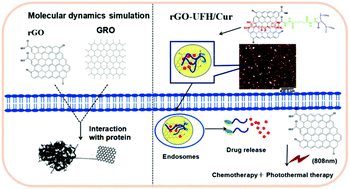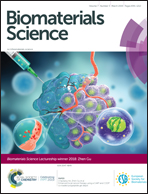Heparin-reduced graphene oxide nanocomposites for curcumin delivery: in vitro, in vivo and molecular dynamics simulation study†
Abstract
Graphene-based nanomaterials (GBNMs) have great potential in drug delivery and photothermal therapy owing to their unique physicochemical properties. However, inferior water solubility and biocompatibility related issues greatly restricted their further applications. Herein, to rectify the obstructive problems, we prepared uniform and smaller sized graphene oxide (GO) nanosheets (∼85 nm) via a modified Hummers’ method, which exhibited significantly improved hemocompatibility compared to random large sized GO nanosheets prepared by a common method. Then, we grafted unfractionated heparin (UFH) onto reduced graphene oxide (rGO) covalently using adipic acid dihydrazide (ADH) as a linker to fabricate biocompatible nanocomposites for the cellular delivery of curcumin (Cur). The novel nanocomposites showed quite a small size of 42 nm in average lateral dimension and exhibited a significantly stronger photothermal effect than GO nanosheets. Besides, in vitro cell experiments verified that the potential anticancer efficacy of Cur-loaded vehicles and cytotoxicity of rGO-UFH/Cur against MCF-7 and A549 cells could be further enhanced under 808 nm irradiation, suggesting the possibility of combinational chemotherapy and photothermal therapy. Moreover, consistent with the in vitro sustained drug release performance, an in vivo pharmacokinetics study also indicated that the retention time of Cur could be significantly prolonged when loaded on rGO-UFH nanocomposites than in free Cur solution. Notably, we firstly discussed the interaction between rGO and Cur, and demonstrated the meliorative biocompatibility of uniform rGO compared to GRO via a molecular dynamics simulation (MD) study. Thus, the in vitro, in vivo and computational study demonstrated that the small sized rGO-UFH nanocomposites had wide application prospects as drug delivery vehicles.



 Please wait while we load your content...
Please wait while we load your content...